

Table of contents
- native species
- wall lizard
- sand lizard
- Eastern and Western green lizard
- wood lizard
- Croatian mountain lizard
- food
- hibernate
- garden maintenance
Some people may remember seeing a lizard sunbathing on a wall or rock in the wild. Many children and young people will hardly have the opportunity, because native lizards are endangered and only rarely found. It is all the more important to give the beneficial insects a suitable habitat in your own garden.
native species
Lizard species native to Germany and Central Europe are:
- wall lizard
- sand lizard
- Eastern and Western green lizard
- wood lizard
- Croatian mountain lizard
Their areas of distribution differ greatly, but they all have one thing in common in the garden. Since insects are part of their diet, they can prevent excessive spread of pests and thus help to protect plants. If you want to specifically promote them in your own garden and thus use them as natural pest controllers, you have to offer them an appropriate habitat for this. To do this, of course, it must first be known which lizard species it is.
wall lizard
Size: 22 to 25 cm
Anatomy: very slender with a relatively long tail
Color: brown to grey, males with black dots or web pattern on back
Distribution: southern and western Germany, wine regions around the Moselle, Neckar and Rhine
Habitat: Dry stone walls, rocks, stony areas
mating season: March to June
Food: insects, spiders
Wall lizards are strictly protected and are already on the early warning list of the so-called red list due to the dwindling number. The red list lists endangered animal species that require special protection.
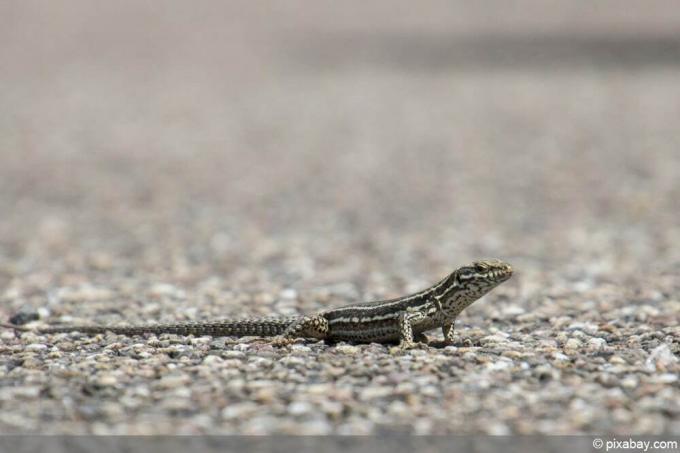
If you want to welcome the wall lizard in your own garden, you should create a dry stone wall, pile of stones or a rock garden that is particularly sunny and warm. Wall cracks, crevices and small caves are very popular with the lizards and serve as life-saving hiding places - both for themselves and for their eggs. There are up to three of these between March and June. Hatching occurs two to three months after the eggs are laid. In order not to disturb or even damage the eggs in the clutches of the wall lizards, no changes should be made to the stone landscape during this time.
sand lizard
Size: up to 24 cm, mostly smaller
Anatomy: strong body, distinct head, short legs and relatively short tail
Color: green, gray and brown possible, mostly patterned
Distribution: all over Germany but rarely
Habitat: Walls, densely overgrown areas, wild gardens, quarries, forest edges and heaths
mating season: March to July
Food: Worms, Insects, Spiders
Sand lizards were once widespread because they are not restricted to one habitat. They prefer areas with dense vegetation and open spaces. As a result, they often occur in border areas, such as a dry forest edge.
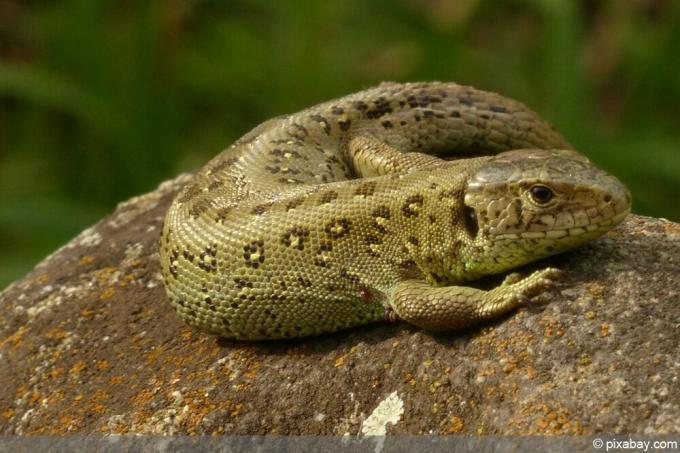
In the home garden, this lizard species can be offered a suitable habitat if a section of the garden is allowed to run wild or is overgrown very densely in some other way - and no care measures are taken must. Stones and warm, dry walls are also gladly accepted. Again, it should be noted that from March to around September or October there is no encroachment on the area reserved for the sand lizards. Both the animals and their clutches could be damaged and frightened by this.
Eastern and Western green lizard
Size: up to 35 cm
Anatomy: slender, pointed head
Color: initially brownish, later green on the body, sometimes with blue markings on the head
Distribution: Eastern Green Lizard in East Germany and along the eastern Danube, Western Green Lizard in Hesse and the Rhine Valley
Habitat: Overgrown slopes with wet soil
mating season: March to about June
Food: Snails, larger insects, spiders, small vertebrates (such as young mice)
The green lizards are very impressive animals due to their color and size, but unfortunately they are only found very rarely. Due to a very small gene pool in the eastern and western populations, infertile offspring are increasingly occurring despite relatively large clutches of up to 15 eggs. The number of lizards is therefore shrinking more and more.
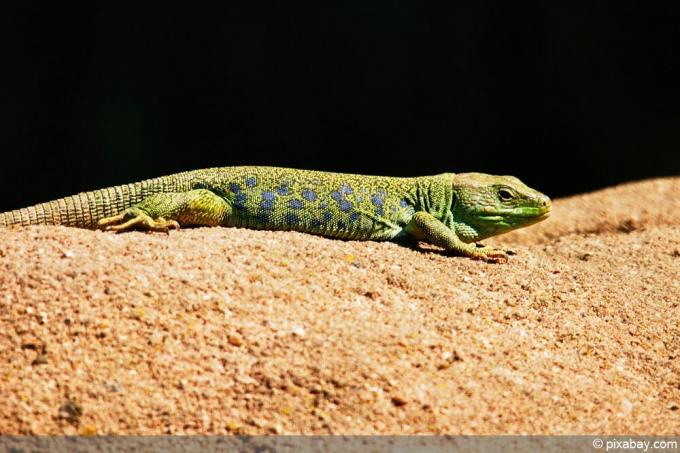
Their preferred living area consists of slopes, which, however, must not be too dry. Due to increasing changes in agriculture, these areas are being mined more and more. A living space in the garden can actually only be offered to them by offering a wildly overgrown, damp slope. Again, this is only possible in very few cases.
wood lizard
Size: about up to 18 cm
Anatomy: slender, very long tail of up to two thirds of the entire body length
Color: brownish, partly with stripes on the back
Distribution: throughout Europe
Habitat: Heaths, moors, quarries, mountain landscapes, lowlands, forest edges, grassy fields
mating season: April to May
Food: small insects and spiders
Although the wood lizard is widespread, it is rare, like other lizards overall. In the home garden, it is important to offer them sufficient hiding places and undisturbed areas. Again, stones and dry, warm walls, overgrown sections and as few interventions as possible are optimal.

Due to their small size, the wood lizards only eat small insects such as caterpillars, flies and small beetles.
Croatian mountain lizard
Size: 16 to 18 cm
Anatomy: slim and petite, tail much longer than body
Color: beige to brownish with darker stripes on the back but also light gray or green
Distribution: Croatia, Slovenia, Austria, Northern Italy and German Alps
Habitat: rocky, bushy areas, in rather humid and cool areas
mating season: Spring to summer, so far little is known about reproduction
Food: Snails, insects and spiders
The Croatian mountain lizard can occasionally be seen in groups, but it is very agile and agile and also very well adapted to its preferred subsoil. A suitable habitat can be created in your own garden with dry rock gardens and dense planting.
food
In order for the native lizards to find sufficient and suitable food in the garden, no pesticides may be used. Because this not only reduces the insects, but also becomes a potential poisonous bait for the lizards.
If you do not want to drive the reptiles out of the garden, but want to offer them appropriate habitats and food sources, you should pay attention to the following factors:
- Setting up an insect hotel
- Only use natural-based pesticides, such as plant manure, when necessary
- Leave a corner of the garden to overgrow
- Plant insect-attracting plants
- Cracked walls or piles of rocks where insects can colonize
- Leave rotten wood
- Bring in wild perennials
- Leave the garden as natural as possible
hibernate
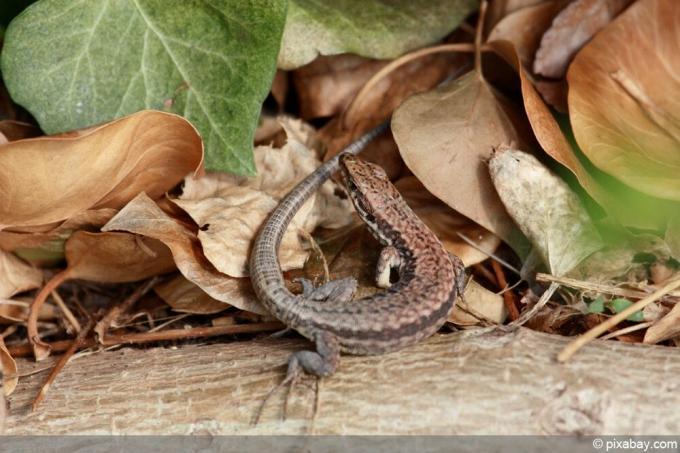
Lizards are cold-blooded animals that become rigid when the temperature drops. In order to survive the winter in this way, they need sufficient reserves on the one hand and a hiding place that is as frost-free as possible on the other. They can create reserves as long as there are enough insects in their area. As hiding places they prefer the abandoned underground burrows of other animals such as mice, moles and rabbits. Humans initially have no direct influence on this, but should refrain from closing existing corridors or blocking the entrances. Heaps of leaves or rocks, which are protected with brushwood and leaves, also offer the lizards hiding places during the winter.
If a lizard is found outside of a hiding place, it can be housed in a cool but frost-free room. A terrarium lightly filled with foliage is suitable to provide the lizard with shelter and security. It is also important with this form of hibernation to check the lizard frequently but carefully. It should not be disturbed every day, but it must be known whether it is really hibernating or whether it is already active again due to high temperatures. If it is active because the temperature rises above 10°C, it also needs to be fed.
As a rule, it is therefore better - if there are still plus temperatures - to keep the lizard close during the day to a protected area and look for a suitable hiding place there themselves to permit. Again, piles of leaves or cairns are good places to set them down.
garden maintenance
With the exception of the wood lizard, all native lizards lay their eggs. The wood lizard, on the other hand, carries it in a sack on its body until it hatches and thus brings its offspring alive into the world. Special consideration should be given to these clutches and the growing offspring from spring to autumn. Again, a few points can be observed to give the reptiles in your own garden the best possible chance of survival. These include:
- Create hiding places such as walls and cairns with cavities and dense planting
- Allowing an area of the garden to overgrow
- No digging or mowing the lawn in the overgrown garden area
- If possible, do not carry out any very noisy or large-scale grooming measures during the respective mating season
- Adapt the "wild" area to the peculiarities of the respective lizard species
Tip:
Unfortunately, even with the measures mentioned, there is no guarantee that native lizards will settle permanently. A "wild" garden corner, offered hiding places and gentle care of your own greenery gives numerous animal species the opportunity to inhabit the garden.
 garden editorial
garden editorial I write about everything that interests me in my garden.
Learn more about beneficial insects

What does hedgehog droppings look like? | Recognize hedgehog droppings
Hedgehogs are not only very cute, but also useful animals. a. devour the unpopular slugs in the garden. They feel particularly comfortable in natural gardens. Their legacies, which can even be hazardous to health, are less pleasant.

What does raccoon droppings look like? How to recognize him
Raccoons are purely outwardly, quite cute contemporaries. However, this does not hide the fact that these are wild animals that can cause great damage in the garden and on the house. This masked intruder can pose a danger to residents and pets.
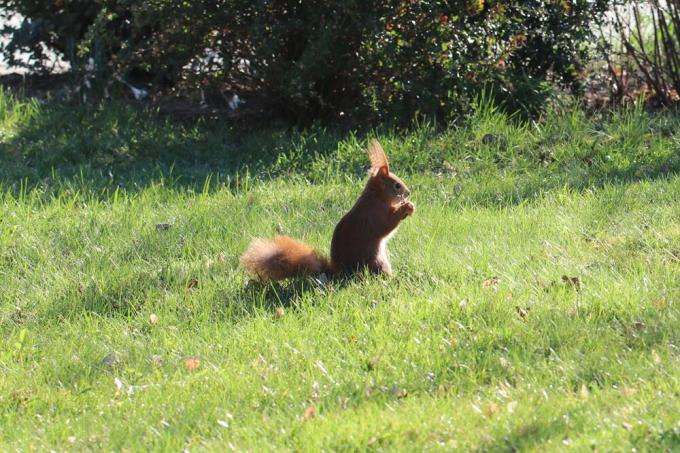
Recognizing squirrel droppings: typical appearance with picture
Gardens provide an oasis for many wild animals to forage there. The animal visitors leave clearly visible traces in the form of droppings. If you take a closer look at the pieces of excrement, you can see which animal was the cause based on certain clues.

Recognizing fox droppings: 5 characteristics with a picture of the fox droppings
If animal droppings are found in the garden, it is annoying in any case. However, there can also be a danger with fox droppings in particular. But how can fox droppings be recognized and what should be considered when removing it?

drive away wild bees | What to do against wild bees in the garden?
If you want to drive away and get rid of wild bees, you should use natural and gentle means. Because the insects are useful in the garden and generally important for the environment. In addition, they are rarely threatening. We reveal how the fight works.

List: these ant species exist in Germany - ants
Ants can be found everywhere, whether in the forest, on a roadside, in the garden or even on the terrace and in the house if there is something interesting for the animals. But not all ants are the same, there are over 13,000 species of ants worldwide, 200 of them in Europe alone.



